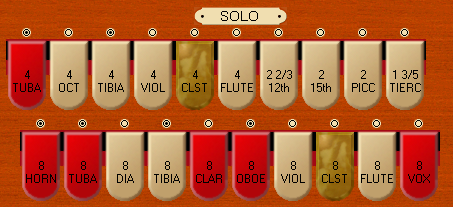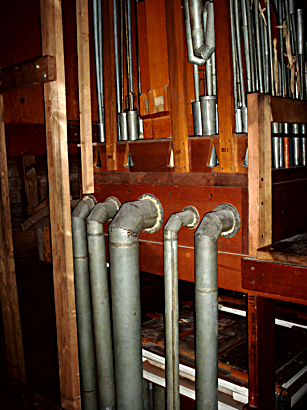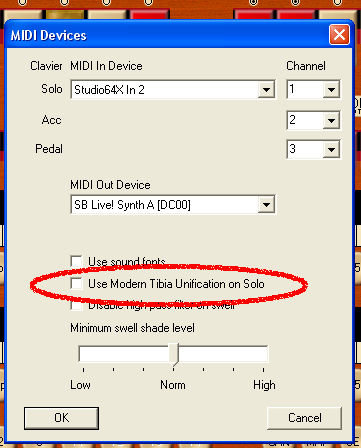| The
MiditzerTM Console Stops, part 3... |
|||
THE MIDITZER The Console Tech Session ELSEWHERE
|
You will see
two 2 foot stops, the 15th and the Piccolo. The 2 foot stops play
two octaves higher than nominal. The 15th is the Viol
d'Orchestre, to confuse the classical organists who would expect this
to be a Diapason. The 2 foot Piccolo is the Flute. That
wouldn't be confusing except that there is a 4 foot Piccolo on real
Wurlitzers and the 4 foot Piccolo is the Tibia. I made life easy
for you and labeled the 4 foot Tibia as a Tibia. 
Not shown in the
picture above are the three 16 foot stops for the Solo. These
pipes are twice as long as the unison pipes and play an octave below
nominal pitch. The "16 BOUR" for Bourdon is the Flute. The
bottom octave of a 16 foot rank of pipes is large and expensive to
make. Sometime you will see 16 foot stops marked "Ten. C" for
Tenor C as in the real stop pictured above. This means that the
lowest pitch available is the Tenor C, an 8 foot pipe. The bottom
octave of the manual will be silent for such a stop. Since
virtual pipes are small and inexpensive regardless of pitch, all the
ranks on the Miditzer play the full compass of the keyboard. The two stops we
haven't discussed yet are the "2 2/3 12th" and the "1 3/5
Tierce". These are called mutations and both are Flutes on
original Wurlitzers.
The 2 2/3 will play an octave and a fifth above nominal. The 1 3/5 will
play two octaves and a third above nominal. If you know something
about chords, you might realize that playing the 2 2/3, 2, and 1 3/5
together will play a major triad. Try it down low on the
keyboard. Use the mutations sparingly. They have quite a
strong effect. If you are a
Hammond player, you might notice that the Flute is available at 16, 8,
4, 2 2/3, 2, and 1 3/5 pitches. It is my personal theory that
Lauren Hammond derived some of the inspiration for the Hammond organ
from the Flute on the theatre organ. You can use the Flute in
somewhat the same manner as the Hammond drawbars but without the
versatility of being able to draw the pitches at a variety of
intensities of course. There are seven chromatic percussions on the Solo manual. These play less than the full compass of the keyboard just as the real stops do. The Harp and the Marimba (MRIM) are the same instrument with Harp being a single stroke and the Marimba reiterating. Obviously you can't do both on the same note at the same time. The Miditzer doesn't have this quite right yet, so just be aware that if you turn on both Harp and Marimba you may not get what you expect. The same is true for the Glockenspiel (GLCK) and the Orchestra Bells. As I have watched professional theatre organists at work, I have observed that they frequently use the chromatic percussions as part of their registration to provide an initial attack to the sound of the pipes. The chromatic percussions do not always have to be used in a way where their presence is particularly obvious. The groups of stops for the Accompaniment (lower) manual and the Pedal are similar to the stops for the Solo but not as extensive. As you would expect, these stops are selected to provide sounds that make a good accompaniment. A few idiosyncracies of the Pedal are worth noting. The 8 Cello stop is yellow indicating it is a Celeste, but there is no corresponding white string stop for it to cleste with. The 8 Cello turns on both the in tune and the celeste ranks to save a stop tab. Some organs use this practice throughout as the strings stops are normally used with the celeste and this saves space on the stop rail. You'll know if this is the case because the string stops will be yellow.  Organ pipes are placed on wooden boxes called wind chests. The chests are supplied with air under pressure. The chests include valves under each pipe to admit air to the pipes as directed by the stops and keys. In the photo above, taken in the Solo chamber of the Los Angeles Orpheum theatre, you see 5 ranks of pipes on their chests. Notice that each chest has a seperate wind supply. The middle rank is the Tibia which requires a lot of wind, hence the large supply line. The English Post Horn is the second rank from the right. Despite its power, it doesn't require much wind because it is a reed pipe, hence the small wind line. The bottom octave of pipes is often mounted on a seperate chest called an offset. This allows the smaller pipes to be mounted in a smaller space and the larger pipes to be placed where there is more room. The significance to the performer is that the offset chests often are not connected to the tremulants. The tremulants are devices that deliberately exhaust air from the chests to introduce fluctuations in the wind pressure to cause the pitch and volume of the pipe to waiver. The tremulant effect is not particularly effective or desirable in bass notes. Not connecting the offset chest to the tremulant serves both a musical pupose and simplifies the winding of the pipes. You will discover that some of Bruce Miles' cinema organ ranks have bass octaves that are "off trem." The Accompaniment and the Pedal include Trap Stops, things like drums and cymbals. (Those are real instruments on a real Wurlitzer.) The traps require that there be a little separation between successive notes or they will not sound. That is the way a real Wurlitzer works. The traps are not particularly realistic in their sound at the moment. One interesting wrinkle in the development of the "theatre organ sound" is the use of the Tibia as a dominant sound. If you study the specification of small Wurlitzers you will discover that original small Wurlitzers did not provide for the kind of use of Tibias that dominates theatre organ music today. The 216 provides the Tibia only at 8' and 4' pitches on the Solo, which was typical of all two manual and many three manual Wurlitzers. A very common "modernization" of a Wurlitzer is to rewire the relay so that the 16' Bourdon, 2' 2/3 12th, 2' Piccolo, and 1 3/5' Tierce stops on the primary manual (solo on a two manual Wurlitzer) control the Tibia rather than the Flute. You can select whether you want to modernize the Miditzer using the MIDI Devices settings:  It is interesting to compare the character of the organ with and without this change. If you are playing a real Wurlitzer remember that there were only 73 pipes in an original Tibia rank as compared to 97 pipes in the Flute rank. If the Tibia unification has been modernized the 16' Bourdon is likely to be tenor C (silent in the bottom octave) and the 2 2/3 and higher pitches may not go to the top of the keyboard. The cinema organ sound font is not as limited in this regard.  The short tabs labeled "SECOND TOUCHES" are for the second touch feature which is not yet implemented in the Miditzer. So if you don't know what second touch is, you'll have to wait to find out or ask someone else. Last
update 10/24/2004
© 2004 Jim Henry All Rights Reserved
|

